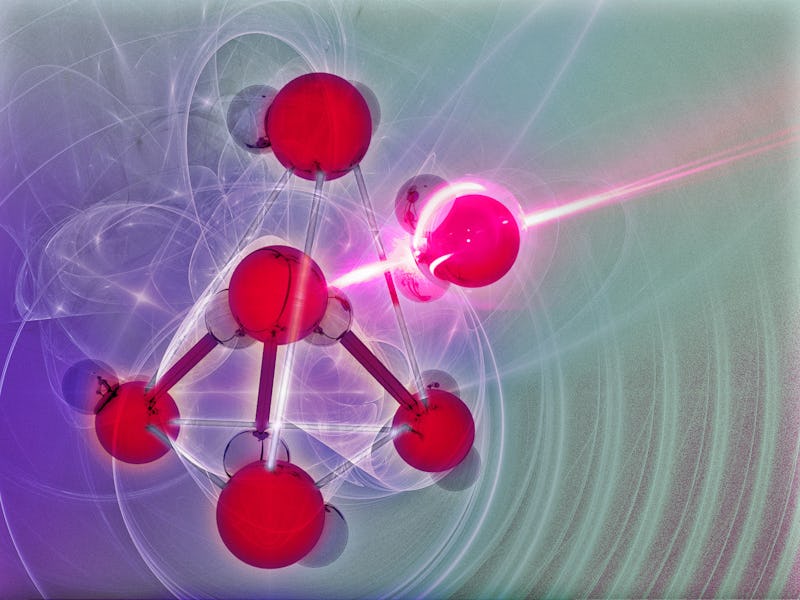"Supercooled" two-in-one discovery explains bizarre water behavior
From dark matter to climate science, supercooled water can play a crucial role.

When water gets cold enough, it turns into ice. But what if the seemingly most-obvious physics lesson you know wasn’t true? What if water just got colder and colder?
Under the right conditions, it can happen. It’s known as “supercooled water,” water that remains liquid even below freezing temperatures. It's actually two liquids in one.
A study published Thursday in the journal Science investigates the properties of this unusual condition and suggests that there’s more to learn about even the most common of substances on Earth.
Water itself has many odd properties. Greg Kimmel of the Pacific Northwest National Laboratory has worked with physicist Bruce Kay for the last 25 years studying water, drawn to it not only because of its universal familiarity and many uses but because “as far as liquids go, it is stranger than most,” Kimmel tells Inverse.
As an example, they point to ice cubes. When water freezes, it actually expands, allowing ice cubes to float. “The course of evolution on this planet is different because ice floats,” Kay tells Inverse.
How cold water can get before it must freeze is a matter of intense scientific debate, Kimmel tells Inverse.
But the conversion into ice doesn’t happen solely because of cold temperatures. When there’s no seed crystal or nucleus for water molecules to begin forming crystal structures, water’s form of matter won’t change. To keep a nucleus from forming, the water must be free from impurities (which could form a nucleation site) and movement (stirred molecules could also form a site).
Supercooled water is well-known to scientists and creating it can make for a great science experiment for kids or YouTube video, since a sudden shake can suddenly provide a nucleus for the molecules to freeze on and provide a very cool quick-free visual.
But on a structural level, mysteries abound. Liquid water at a supercooled temperature “is not only relatively stable, it exists in two structural motifs. The findings explain a long-standing controversy over whether or not deeply supercooled water always crystallizes before it can equilibrate. The answer is: no," Kimmel says in a press statement.
By equilibrate, Kimmel tells Inverse, he means that the molecules “can sit there and act like water before it freezes.” At extremely cold temperatures, Kimmel says, water is going to freeze.
"When it's that cold, you maybe only have a 1,000,000th of a second before it freezes. But for the water molecules dancing around, that's long enough for them to say, I've gotten the structure I want. I'm not going to change.”
Understanding why water can float as it freezes shows how weird a substance it can be.
Working with postdoctoral scientists Loni Kringle and Wyatt Thornley, Kimmel and Kay used infrared spectroscopy, which means the interactions of infrared radiation with matter, to observe how water molecules would react when a laser was fired at a block of ice — making supercooled liquid water for a few nanoseconds. Kay compares the start-and-stop process to a “claymation movie.”
The laser tests were run several times, proving that all of the structural changes were reversible and reproducible.
There are a number of potential uses for supercooled water: Scientists have suggested that its quick freezing process could be used to detect dark matter. Kimmel suggests a role in studying climate, noting that cloud coverage plays an important role in temperature which is “related to how clouds form and how supercooled water in the atmosphere crystallizes.”
He also notes that seeing what happens to very cold water in certain conditions for a millisecond is, perhaps, “esoteric.” But considering water’s crucial for humanity, he thinks its worth understanding to the fullest.
“If ice didn't float, lakes and rivers would freeze from the bottom up in the winter, and fish the way we have them right now wouldn't be there,” Kimmel says.
Abstract: A fundamental understanding of the unusual properties of water remains elusive because of the limited data at the temperatures and pressures needed to decide among competing theories. We investigated the structural transformations of transiently heated supercooled water films, which evolved for several nanoseconds per pulse during fast laser heating before quenching to 70 kelvin (K). Water’s structure relaxed from its initial configuration to a steady-state configuration before appreciable crystallization. Over the full temperature range investigated, all structural changes were reversible and reproducible by a linear combination of high- and low-temperature structural motifs. The fraction of the liquid with the high-temperature motif decreased rapidly as the temperature decreased from 245 to 190 K, consistent with the predictions of two-state “mixture” models for supercooled water in the supercritical regime.
This article was originally published on